|
More Yield with Less
Water. How Efficient Can be Water Conservation in Agriculture
?
Prof. Dr. Dieter Prinz & Dr. Amir H.
Malik
Institute of Water Resources
Management, Hydraulic and Rural Engineering, Dept. of Rural Engineering,
University of Karlsruhe, D-76128 Karlsruhe, Germany, e-mail:
MALIK@iwk.uka.de
Abstract
In rain-fed as well
as in irrigated agriculture the urgency rises to implement water conservation
measures, defining water conservation as
“measures designed to promote
efficient use of water and to eliminate waste of water”. Besides
supply side measures we have a wide variety of water demand management
measures, which can be grouped into measures to reduce losses, and
measures to increase the efficiency of water applied.
Pits,
furrows, basins, bunds, ridges and terraces can be employed as useful to
minimise runoff losses allowing better soil infiltration. Evaporation
losses can be minimised by mulching and shading and the water storage capacity
through incorporation of organic matter and deepening the root zone. To reduce
transpiration wind breaks and improvement of shading of crops are being
the most important techniques.
Other important water
conservation methods are e.g. increasing the efficiency of irrigation
water use, selecting best suited crops and cropping methods, and reducing the
losses of stored water and improving the water availability. Efficiency increase
in irrigation water can be accomplished e.g. by application of “supplemental”,
“deficit” or “surge” irrigation. Efficient irrigation methods like
micro-sprinkler, trickle, or pitcher can be applied. Losses have to be
avoided in conveyance (losses can be 30-50%), distribution and application. To
achieve optimum water conservation & improved water use efficiency, education
and training, public incentives, management of supply infrastructure, an
optimised resource policy and further research are needed.
Keywords
Water conservation, irrigation methods, water supply management, water demand
management
Introduction
Water is already in many parts of
the world a scarce commodity – and will be of even shorter supply in future: Due
to an ever increasing world population, improving standard of living,
irregularities caused by global climate change and growing water pollution, the
world water problems aggravating day by day. Especially the drier parts of the
tropics and subtropics, but also European countries, experience severe water
supply problems – and agriculture will be hit hardest. Agriculture
utilizes globally about 70 % of all the water managed by man, and about 80 % of
the water used in the developing world (Prinz 2000). At the same time, the
competition between the various sectors – agriculture, communities, industry,
nature, becomes stiffer and
agriculture will be the loser in the run for scarce water resources, as the
output per unit water is of significantly lower value than in the other economic
sectors. On the other hand, the need for more food asks also for more irrigation
water, therefore we have to
find ways of growing more food with less water (Agarwal 2001). But it is not
only a problem of water quantity, but of quality due to increasing pollution,
too.
General overview
What is Water
Conservation in general ? Water conservation is the physical control,
protection, management, and use of water resources in such a way as to maintain
crop, grazing, and forest lands, vegetative cover, wildlife, and wildlife
habitat for maximum sustained benefits for people, agriculture, industry,
commerce, and other segments of the national economy.
Water conservation
in agriculture may be defined as the application of measures designed
(1)
to
improve the availability of water for agricultural purposes ("Supply
Management"),
(2)
to
reduce the present size of water demand ("Demand Management"), and
(3)
to keep water resources from being polluted or wasted.
The solutions found
must be sustainable and possible negative effects e.g.
on nature have
to be avoided.
Water conservation must be an
integral part of „Integrated Water Resources Management“, a long-term
integrated strategy which seeks to make best use of the available water
resources (Fig.1). Major features are:
v
Surface water
management: By diverting
(more) water from rivers, e.g. by construction of hydraulic structures in rivers
considerable quantities of water can be saved and used for agriculture,
especially during the rainy season and under flood conditions. More reservoirs
of high water holding efficiency are needed in future to cope with future water
demands.
v
Groundwater
management: Groundwater tables are falling in most parts of the world and
sustainable groundwater management deserves artificial groundwater recharge.
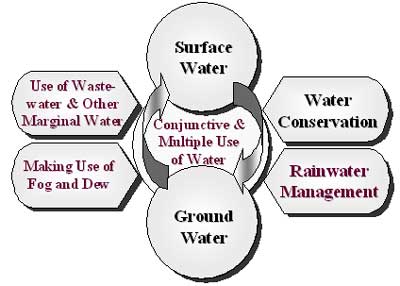
Fig 1: Water Conservation has
to be an integral part of every "Integrated Water Resources Management" system
v
Surface- and
groundwater have to be used in a conjunctive way.
v
The multiple use
of water (“using every drop of water four times before draining it”) is
essential to cope with future water demand.
v
Rainwater
management: Rainwater
management can be either "in-situ moisture conservation" or "Water Harvesting".
Water Harvesting is defined as "the collection and concentration of rainfall
(and overland flow) and its use for the irrigation of crops, pastures and trees
for domestic and livestock consumption". The water storage can be done in the
soil matrix or in a reservoir (Prinz
and Wolfer 1998).
v
Rain and surface
runoff management serves also the purposes of soil conservation, – a
prerequisite for water conservation-, and flood control.
v
The use of waste
water, drainage water and other marginal water sources becomes more and
more imperative to cover the demand. It is one of those measures which need very
close supervision to avoid damage to soils and plants – at least on a long term.
Wherever the natural
conditions allow it, the use of fog and dew should be promoted to cover
agricultural water demand.
Besides these supply side measures
we have a wide variety of water demand management measures, which
can be grouped into:
v
Measures to reduce
losses, and
v
Measures to
increase the efficiency of water applied.
As these demand side measures are
regarded as the core measures of water conservation, water conservation is often
defined as “measures designed to promote efficient use of water and to
eliminate waste of water”.
The term “efficient use of water”
is a very critical one: The efficiency might be defined as " unit of water used
by crops to produce one unit of dry matter" or "…to produce one unit of
harvested produce".
When water is in short supply,
farmers are very much interested in increasing the efficiency by limiting
unproductive water losses (evaporation from soil, surface runoff, seepage). Even
if the farmers can increase the efficiency per unit water available in their
fields, this does not necessarily improve general, regional water efficiency.
Reduced seepage e.g. means a lower
recharge of groundwater, less surface runoff means reduced surface water flows
and fewer opportunities for using water further downstream, including less water
supply for river valleys and wetlands. Therefore, we have to distinguish between
recoverable water losses and unrecoverable water losses; the
latter ones are those quantities of water lost to the atmosphere, to saline
aquifers or to the sea.
When looking at water conservation
measures (Figure 2), we might distinguish between three groups of measures.
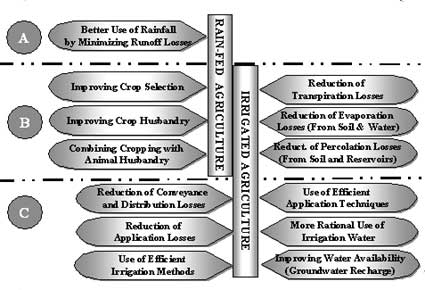
Fig.
2: Groups of measures to be
applied in water conservation either in rain-fed cropping (A), in irrigated
agriculture (C) or in both sectors (B)
A:
measures are only applicable under rain-fed agricultural conditions
B:
measures which are relevant to save water as well as in rain-fed
agriculture as well as in
irrigated agriculture and
C:
measures which are relevant in irrigated agriculture only.
Measures in rain-fed agriculture only (A)
Globally, rain-fed agriculture is
practised on 83% of cultivated land and supplies more than 60% of the world’s
food (FAO 2001). In–situ water conservation, often combined with water
harvesting measures, can contribute significantly making better use of the rain
in dry areas to supply the crops during the rainy season with sufficient water.
One element of in-situ moisture conservation is the curbing of runoff losses,
which can amount to 30-50% of rainfall on sloping grounds.
Runoff losses
can be minimized e.g. by
v
Tying ridges: A
tied ridge system can double crop yields in semi-arid areas, while
simultaneously preventing soil erosion. The water storing capacity in a tied
ridge system amounts to 40-70 mm.
v
Cultivating crops in
furrows
v
Construction of
earth basins and sunken beds to cultivate crops in them. A very
remarkable example is the Zay technique (Chritchley
et al. 1992). Pits of 30 cm diameter are dug, 90 cm apart and 15-20 cm
deep. An experiment in Niger showed a doubling of yield from 600 kg/ha on a (manured)
field without Zay to 1200 kg/ha on fields with Zay pits (Fatondji at al. 2001).
v
Lines of stones
and trash, bunds and ridges
v
Contour farming
and strip cropping are also well established measures in soil and water
conservation.
v
The application of
Fanya Juu techniques, catching the rain in uphill or downhill trenches and
inducing the establishment of terraces over a longer period.
v
Construction of
ditches and basins to retain water in the field
v
Construction of the
various kinds of terraces; level terraces with lips and reverse sloped
terraces are being the most efficient ones.
Measures being applied as well for rainfed agriculture as for irrigated
agriculture (B)
Improving crop selection
It is well established, that
different crops need rather different quantities of water to produce a yield.
Rice, e.g. is a very water intensive crop, using twice as much water per hectare
as wheat (FAO 2001). When farmers decide to switch from rice cultivation
to any so called upland crop, this will save substantial amounts of
water. But the cultivation of less water demanding crops than rice is not the
only measure suggested in this respect:
-
using crops of high water use efficiency
-
using well adapted, high yielding varieties; short – strawed wheat gives
double or triple yield per unit water in comparison to the traditional
varieties.
Improving crop husbandry
In areas with a short rainy season,
the right timing of the crop is a decisive feature, as well as the type
of cropping, e.g. relay or sequential cropping.
A high water use efficiency
can only be achieved if all the other growth factors are kept near the
optimum. Important elements in this respect are:
v
nursery techniques
with optimal water supply, but little percolation
v
optimal seeding
density and seeding methods, e.g. “dry seeding”
v
the optimal
association of crops
v
crop protection,
to avoid any suffering of the crops from pests and diseases
v
supply of
nutrients, i.e. the manuring and applying mineral fertiliser
v
timely weeding
of the crop to avoid water losses by unwanted plants.
Figure 3 shows an example of water
production function for maize under Kenyan conditions, illustrating the
dependency of the yield level under given rainfall conditions from the level of
management.
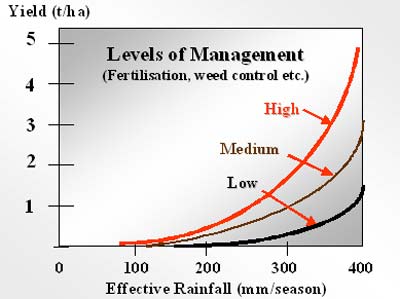
Fig.3:
Water-production function for maize in Machakos District, Kenya.
Source: Beets 1990
Combining cropping with animal husbandry
According to Cape (1995) it needs
700 l of water to produce one litre of milk. This water, of course, is
needed to produce fodder plants and one kg of alfalfa hay needs roughly 600 l of
water. The combination of cropping and raising animals, e.g. cows, can be very
water efficient as can be the cultivation of fishes in rice fields (aquaculture).
Reduction of transpiration losses
Transpiration of plants counts for
the largest share of the water used by a crop stand. The high evaporative demand
of the atmosphere determines largely the amount of water lost by transpiration.
If the air suction is higher than the water supply of the plant, the closing of
the leave pores (stomata) is a counter measure, but a measure which lowers
productivity. The grower can interfere by two means: (1) by reducing wind
speed, e.g. by planting shelter belts and (2) by planting crops in
greenhouses (Figure 4) or in plastic tunnels. Measure 2 is the cultivation of
crops under shade trees or in shade houses. The breeders have
already succeeded in breeding a number of new grain varieties with lower
transpiration rates per kg of dry matter produced.
Reduction of evaporation losses
According to Hudson
(1987), shading the water surface can substantially reduce the evaporation
losses. The more of less
unproductive evaporation from soil and water surfaces should be reduced wherever
possible. Under irrigation, the evaporation losses depend strongly on the
irrigation method and technique applied. Sprinkler irrigation e.g. wets all
surface whereas under drip irrigation the wetted surface remains rather small.
Proven measures are e.g.:
v
The application of
mulch layers of organic origin or as plastic mulch
v
The use of certain
cover crops, which need less water for transpiration than they save from
evaporation
v
The use of
conservation tillage which disturbs to a lesser degree the ground, but
disturbs the capillary rise of the water to the surface.
v
Various systems of
agro-forestry produce shade and reduce temperatures for the annual crops
grown below. Shade trees often belong to the Leguminosae family.
v
Contour hedges and
shelter belts reduce wind speed.
v
As already mentioned,
greenhouses and tunnels reduce not only transpiration but also significantly the
evaporation from the ground.
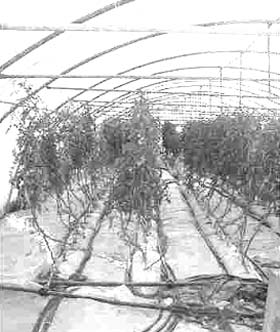
Fig.4: Tomato cultivation
using the bag culture technique with drip irrigation in a greenhouse in S.
Tunisia. Evaporation is minimised and transpiration losses are reduced.
Drip-irrigation is employed in less that 1% of the world's irrigated area but
the potential for efficiency increases is enormous.
Open water surfaces
can be only marginally protected from high wind speeds or high temperatures.
Fatty alcohols can be sprayed on water surfaces as evaporation retardant
(UNEP 1998). About 50 mg /m2 per day of the chemical are required and
can result in the saving of 30% of the daily loss of water due to
evaporation. Floating material has being used, too, but there are still too many
drawbacks related to those measures, and therefore the implementation was very
slow until now.
Reduction of percolation losses
Percolation losses occur as well
under rain-fed agriculture as under irrigation, from soils to groundwater layers
as well as from ponds and reservoirs to deeper layers.
Applying the right quantity of
water and wetting only the root zone would be optimal, but this is technically
often not feasible. To improve soil management in regard to water efficiency,
the following measures are recommended:
v
Improving rain water
intake by keeping an open soil surface, by mulching with organic
material and by keeping a high organic content in the soil and a good soil
structure.
v
Improving soil
water holding capacity by keeping a high level of soil fertility (high
percentage of organic material, good structure etc.)
v
Avoiding compacted
layers, e.g. a plough pan, allowing water to reach deeper soil layers and to
increase the wetted soil volume
v
Optimising the
root environment: A soil
environment is optimal for plant growth, contributing to a high water
application efficiency, if it is deep enough, if the soil is well structured and
well supplied with nutrients, if it contains a high water storage capacity, has
no hard pans or stone layers, has no salt and toxic element accumulation and has
no drainage problems.
MEASURES APPLIED IN IRRIGATED
AGRICULTURE (C)
Worldwide, about 60 percent of
global food is produced under rain-fed conditions without any irrigation. But
irrigation water, if in ample supply, reduces considerable the risk of
production and allows yields double as high as the yields which can be obtained
from rain-fed agriculture (FAO 2001). Roughly 40% of the food is produced on
irrigated land, on 17% of the total cultivated land. The water needed for
crops amounts to 1000 – 3000 m3 per ton of cereal
harvested. With other words, it takes one to three tones of water to grow 1 kg
of rice.
As mentioned before, the losses
of water have to be covered as well as number of measures to increase the
efficiency of water use in irrigation.
Reduction of conveying and distribution losses
33-50% of water diverted for
irrigation is lost 'en route': The conveyance and distribution losses are
enormous. By lining the canal system or by conveying the water in pipes, these
losses can be significantly reduced. It should be kept in mind, that at least
the seepage losses are not unrecoverable losses, but might be lifted up
from the groundwater layer downstream.
Reduction of application losses
Application losses are either
surface runoff losses or percolation losses, often summarised as “operational
losses”. The water applied, should be sufficient to wet the volume of root
penetration, but should not go beyond. Numerous technical means are available to
apply exactly the amount of water needed, but financial and labour problems, in
large irrigation schemes also management problems, hinder this.
Use of efficient irrigation methods
The
large differences in water efficiency between the various irrigation methods are
quite well known: Traditional surface irrigation generally achieves only around
40% efficiency, sprinkler irrigation can be 70-80 % efficient and drip
irrigation might reach over 90% efficiency (Wolf and Stein 1998). Modern
irrigation technology could in theory save about half of the water presently
consumed in irrigation, but technical, economic and socio-cultural factors
hinder the transformation of theory into practice. Wolf and Stein (1998) cite a
study made in Israel by Hagan (1994), who found surface rrigation to be 70%
water efficient but drip irrigation only 42-56%.
This deviation from generally believed figures is due to
differences in the available underlying conditions. For the farms using surface
irrigation, water was in very short supply and therefore it had to be used as
efficiently as possible. Drip irrigation on the other hand has been used under
conditions of sufficient water to grow crops of high market value. Low cost of
water and high market prices did not give any incentive to the farmers to use
water efficiently.
Of course there are many examples showing the high
efficiency, e.g. of drip irrigation: in Maharashtra State in India the use of
drip irrigation of pomegranates resulted in saving of about 44% as
compared to conventional check basin irrigation, with a further water savings of
about 14% when compared to unmulched plots (Saksena 2000).
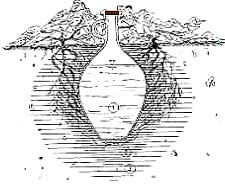
Fig.
5: Pitchers
are a low cost,
traditional irrigation technology, based on local manpower and know how and with
a high water efficiency for garden crops
(Prinz and Malik 2001)
Use of efficient application
techniques
Within the various irrigation
methods (surface, sprinkler, subsurface, drip and micro-sprinkler) there are
application techniques which are more efficient than others. In furrow
irrigation, e.g. surge irrigation can save considerable quantities of water.
Surge irrigation is the practice of intermittently stopping and starting water
flows across a field. LEPA stands for Low Energy Precision Application and is a
very water efficient form of application of water under pivot irrigation
systems. The water is applied near the ground surface below canopy.
In drip irrigation some techniques
were developed which are not as efficient as the more costly ones, but which
allow even small farmers a very high efficiency e.g. in vegetable cropping: the
drip bucket irrigation is such a low cost and relatively efficient
technique, applied already on thousands of farms in East Africa
(Prinz and Malik 2001).
More rational use of irrigation water
Supplemental irrigation
(SI) is the application of small quantities of irrigation water to a rain-fed
crop in times when the demand can not be covered by rainfall (Oweis 1997). SI is
usually practiced usually in the wetter part of the dry areas with 300 to 600 mm
annual rainfall (Oweis et al. 2001). Supplemental irrigation might be taken from
groundwater or from excess water stored during the rainy season. Another
technique which allows a very high water use efficiency under fully irrigated
conditions is deficit irrigation. The deficit irrigation is the
distribution of limited amounts of irrigation water to satisfy essential water
needs of plants. The water supply is reduced in less critical periods of water
demand by the crop and supply of full amount of water during stress-sensitive
periods. A similar technique is the “intermittent submerged irrigation
technique" for rice (ISI). This technique has been promoted in China but it is
now applied in many rice growing areas world wide. Up to 20% of the irrigation
water can be saved, if the paddy crop is not grown under submerged conditions
through out the main growing season, but only intermittently. The phases where
submerged conditions are recommended are those “sensitive” stages mentioned
earlier.
Improving water availability
As mentioned earlier, aquifer
depletion is a common problem in many dry areas of the world. Many techniques
have been developed to artificially recharge aquifers to sustain the water table
and to allow further control of pumping water to cover the water needs of humans
and crops. One interesting example of combined basin irrigation with groundwater
recharge is reported from Uttar Pradesh Province in India (IWMI, 2002). In the
monsoon season, surface water is diverted through an unlined canal system to
provide farmers with irrigation water for rice crops. Around 60% of the
irrigation water applied is used by the plants, most of the remaining 40%
filters through the soil to recharge the groundwater. Combined with seepage from
unlined canals those “losses” provide farmers with groundwater to irrigate dry
season crops. The research showed, that the water table in the study area, which
had been progressively declining, has been raised from an average of 12 m below
ground level to an average of 6,5 m.
Concluding remarks
Important socio economic
factors of water conservation are:
v
Population
stabilization reduces also pressure on water resources.
v
Community
involvement is essential for effective water conservation.
v
Access to water can
be viewed as a human right, therefore a fair distribution should be aimed for.
v
Water conservation
should benefit from a multidisciplinary team.
v
Preference should be
given to the application of nonstructural solutions, for example pricing of
water.
v
To develop water
conservation institutions, public education and awareness are essential.
v
Selection of
appropriate low cost technology is a prerequisite for widespread implementation.
v
Planners should
consider both traditional and modern technologies.
Criteria
to select water conservation
measures are according to Emerson (1998):
*
program costs, * cost-effectiveness,
*
ease of implementation, * budgetary considerations,
*
staff resources and capability, * environmental impacts,
*
rate payer
impacts, * environmental and social justice,
*
water rights and permits, * legal issues or
constraints,
*
regulatory
approvals, * public
acceptance,
*
timeliness of savings, and * consistency with other
programs.
Lessons learnt
from various projects are e.g., that the adoption
of a new irrigation system depends on farmer’s capacity to finance and operate
it, as well as on the type of crop being produced.
A modernised surface
irrigation might be a better water saving technique than drip or sprinkler
irrigation in certain locations; the latter ones are often not affordable. A
modernised 'old' system is also more easily adopted by farmers since it is
closer to traditional practices.
Future
Outlook
FAO expects that the
area of land being irrigated in a large number of developing countries will
continue to increase until 2030 and if farmers apply improved water management
techniques to increase efficiency, an increase of 34 % in irrigated land can
be achieved using only 12 % more water (FAO 2001). To accomplish
this, farmers will have to be more efficient in their use of water, learning to
produce more crop per drop. If this is achieved, no major water crisis should
affect irrigated food production at the global level and future demand for
irrigation water beyond 2030 is expected to continue to slow as world population
growth also slows.
v
Water
conservation policy to be effective, must include both water quantity and
quality in the water conservation programme (Emerson 1998).
v
Efficiency, economy and equity in water use can be ensured through cooperative
management of watersheds and command areas.
v
Conjunctive use of water, including water harvesting and water conservation
should be promoted combining also traditional and new methods.
v
Strong
efforts are needed to transfer the huge amounts of flood and excess rain/runoff
water from the rainy season to the dry season. Storage media are aquifers or
reservoirs, to a lesser extent the soil matrix. Water conservation measures can
provide valuable tools to make best use of this water.
v
Sustainable groundwater exploitation (e.g. through qanat systems) should be
supported and deep drilling, aquifer over-exploitation and aquifer polluting
should be prosecuted.
v
National and international organizations should promote the dissemination of
successful case-studies between countries to avoid or minimize duplication, to
avoid repetition of mistakes, and to enhance collaboration between users.
Future
research fields
will include biotechnology, bioengineering and plant breeding which should be
employed to arrive at species and varieties with a significant lower water
demand. Future research should be multidisciplinary.
To achieve optimum
water conservation & improved water use efficiency, a water conservation
enabling environment is needed that includes (Fig. 6):
(1)
education and training, improvement of systems and public incentives:
these measures might allow in increase in further 20 %
(2)
irrigation management transfer to users, management of supply
infrastructure and an optimised resource policy to arrive at 60 % of the
potential;
(3)
further research of the public and the private sector to utilise fully
the whole available potential.
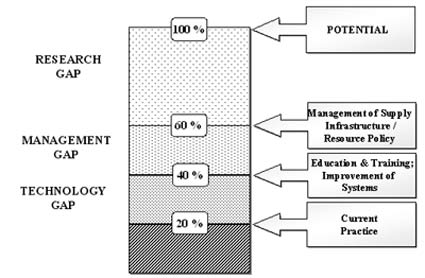
Fig. 6: Ways of making better use of production potential.
Source: Wolff & Stein 1998 (redrawn), based on Cape 1995 (Original data based on
Australian conditions)
Agarwal, A.: 2001,
Increasing water harvesting and water conservation is the only way to ensure
food security. Down to Earth, Vol 10, No. 3, June 30, 2001.
Bastani,
S.: 1998, "Unterflurbewässerung mittels Kuseh-Rohren. Entwicklung eines neuen
Bewässerungssystems mit hoher Wassereffizienz und Bewässerungsversuche in
Karadj/Iran". Diss., Inst. f. Wasserwirtschaft und Landschaftsöko. Heft 26,
Univ. Kiel.
Beets, W.C.: 1990,
Raising and sustaining productivity of smallholders farming systems in the
tropics. AgBe Publishing, Holland.
Cape, J.:
1995, Irrigation Research: Past, present and future.
Irrigation Australia
Vol. 10, 30-32.
Chritchley W., Reij C. and
Turner S. D.: 1992, Soil and water conservation in Sub-Saharan Africa: to- wards
sustainable production by the rural poor. IFAD, Rome and CDCS,
Amsterdam.
Emerson, H.:1998,
Conservation, it’s the future of water. On Tap, Vol. 7, Issue 4,
FAO: 2001, Crops and
drops: Making the best use of land and water. Food and Agriculture Organisation
(FAO), Rome.
Fatondji, D. Martius,
C. and Vlek, P.:2001, .Zai - A traditional technique for land rehabilitation in
Niger. Newsletter
No. 8, Zentrum für Entwicklungsforschung /Center for Development Research,
Universität Bonn, September 2001.
Hagan, H.: 1994,
Constraints to high efficiency in irrigation water management in the Jordan
Valley, Proceedings of the regional seminar, Amman.
Hudson, N. W.: 1987,
Soil and water conservation in semi-arid areas. Food and Agriculture
Organisation (FAO) Soil Bulletin 57 pp.109-122.
IWMI.: 2002, A
success story in reversing groundwater decline.
IWMI Research Update,
June 2002.IWMI, Colombo, Sri Lanka
Oweis,
T.: 1997, Supplemental irrigation: A highly efficient water-use practice.
ICARDA, Aleppo, Syria,
16pp.
Oweis,
T., Prinz, D. and Hachum, A.: 2001, Water harvesting, indigenous knowledge for
the future of the drier environments, ICARDA, Aleppo, Syria, 36pp.
Prinz, D.: 2000,
Global and European water challenges in the 21st century. Keynote Speech, 3rd
Inter-Regional Conference on Environment-Water, “Water Resources Management in
the 21st Century”, 1-3 June 2000, Budapest/Hungary. Proceedings, p. 247 – 254.
Prinz,
D. and Malik, A. H.: 2001, Water Conservation in Agriculture, FAO Training
Course, Draft Version on CD ROM, FAO, Rom.
Prinz, D. and Wolfer,
S.: 1998, Opportunities to Ease Water Scarcity (Water Conservation Techniques
and Approaches). Proceedings, International Conference on "World Water Resources
at the Beginning of the 21st Century" 03 -06 June 1998, Paris. UNESCO-IHP,
Paris.
Rijsberman, F.
R.:2001, Balancing water uses, water for food and water for nature. Thematic
Background Paper, International Conference on Freshwater – Bonn 2001.
International Water Management Institute IWMI,
Colombo, Sri Lanka
Saksena, R.S.: 2000,
Ministry of Water Resources, Government of India, New Delhi. http://www.unep.or.jp/ietc/Publications/TechPublications/TechPub-8e/drip.asp
UNEP: 1998,
Sourcebook of Alternative Technologies for Freshwater Augmentation Some Asian
Countries,
UNEP, Paperback 223 pages.
Wolff,
P. and Stein T. M: 1998, Water efficiency and conservation in agriculture -
opportunities and limitations. Agriculture + Rural Development; vol 5; no 2; pp
17-20; 8 ref.
ANNEX
Case study: Drip Irrigation
Systems (DIS) in India (Saksena 2000)
Drip Irrigation Systems in India
are being praticised since 1970, being used on a limited scale in Tamil Nadu,
Karnataka, Kerala and Maharashtra States, mainly for high value, horticultural
crops like coconut, coffee, grape and vegetable production without the benefit
of any subsidies from the governments. At Rahuri, in Maharashtra State, the use
of drip irrigation of pomegranates, grown in gravely soils, resulted in a
savings of about 44% (as compared to conventional check basin irrigation
systems) with a further water savings of about 14% when compared to
un-mulched plots.
The capital costs involved are
high compared to conventional irrigation systems, but the labor and operational
costs are low in India. The net result is that the benefit-cost ratio for DIS
is very favourable compared to conventional systems since the payback period for
investment very short. The cost of using drip irrigation system is
summarized in the table 1.
With DIS in India, there was an
improvement in crop yields and savings in water use of between 18% and 40%.
Consequently, there was a substantial improvement in the water use efficiency
that ranged up to three times that of conventional surface irrigation methods,
even with the use of poor quality irrigation water. See table 2 for water
savings and increased yields achieved using drip irrigation in Indian case.
Tab. 1: Drip
irrigation cost, water savings v. increased yield achieved in India
|
Crop |
Sugar-cane |
Bananas |
Citrus |
Grapes |
Pomegr-anates |
Guavas |
Apples |
Mosam-bi |
Ground-nuts |
Tomat-oes |
|
% Saving of water |
50 |
50 |
50 |
65
-70 |
50
-55 |
55
-60 |
50
-55 |
60
|
35
|
30
|
|
% increase in yield
|
35 |
50 |
50 |
30 |
30 |
25 |
20 |
50 |
20 |
50 |
|
Cost US $ |
715 |
115 |
575 |
|
|
|
|
|
|
|
|
Payback period (months) |
18 |
2 |
12 |
|
|
|
|
|
|
|
| |
Source: (Saksena
2000)
Case
study: Growing More Rice with Less Water (China) One
method to save water in irrigated rice cultivation is the intermittent
(submerged) irrigation. This example shows real water saving and increase of
production. Production levels remained stable over the time period in spite of
this massive shift of water (see Tab. 2) out of agriculture. Growing more rice
with less water improves also the productivity of water was made possible
through policy, management, and technological changes (Fig.1) (Rijsberman, F.
R., 2001).
Fig. 1, Growing more rice with less water improves also the productivity of
water was made possible through policy, management, and technological changes (Rijsberman,
F. R., 2001).
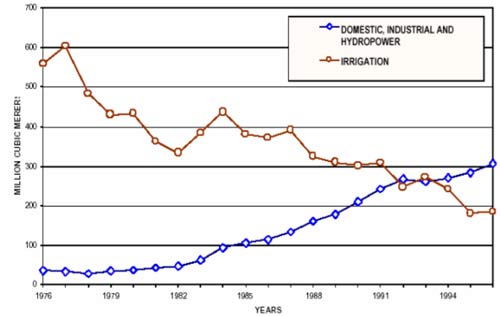
Tab. 2
Changes in land and land productivity in Zhanghe Irrigation District, China
(1966-1998)
Period
|
Annual irrigated
area (103 h) |
Rice crop production (tons 103) |
Rice yield (T/ha) |
Rice water
productivity (kg/m3 water supply) |
|
1966-78 |
139 |
561 |
4.04 |
0.65 |
|
1979-88 |
135 |
905 |
6.72 |
1.17 |
|
1989-98 |
118 |
920 |
7.80 |
2.24 |
|
Source: Rijsberman, F. R., 2001
SOURCE: Prinz, D. &
Malik, A.H (2002). More Yield with Less
Water – How Efficient Can be Water Conservation in Agriculture ?
Proceedings, 5th Internat.
EWRA Conference on Water Resources Management in the Era of Transition,
Athens,
Greece,
4-8 September 2002, (pp 18 - 35).
|
Pakissan.com;
|